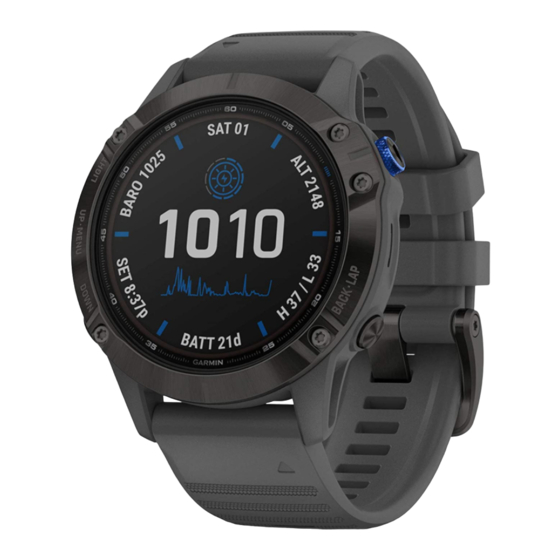Garmin Fenix 6 Gebruikershandleiding - Pagina 22
Blader online of download pdf Gebruikershandleiding voor {categorie_naam} Garmin Fenix 6. Garmin Fenix 6 26 pagina's. Turn on smart watch of 2022 - go wiki
Ook voor Garmin Fenix 6: Faq (5 pagina's), How-To (8 pagina's)

TIP: The device requires a few runs with a chest heart rate
monitor to get an accurate maximum heart rate value and V02
max. estimate. If you are having trouble getting a lactate
threshold
estimate,
try manually lowering your maximum heart
rate
value.
1
From the watch
face,
select@.
2
Select an outdoor running activity.
GPS is required to complete the test.
3
Hold MENU.
4 Select Training > Lactate Threshold Guided Test.
5 Start the timer, and follow the on-screen instructions.
After you begin your run, the device displays each step
duration, the target, and current heart rate data. A message
appears when the test is complete.
6
After you complete the guided test, stop the timer and save
the activity.
If this is your first lactate threshold estimate, the device
prompts you to update your heart rate zones based on your
lactate threshold heart rate. For each
threshold estimate, the device prompts you to accept or
decline the estimate.
Getting Your FTP Estimate
Before you can get your functional threshold power (FTP)
estimate, you must pair a chest heart rate monitor and power
meter with your device
(Pairing Your Wireless Sensors,
page
34), and you must get your V02 max. estimate
Your V02
Max.
Estimate for Cycling, page
The device uses your user profile information from the initial
setup and your V02 max. estimate to estimate your FTP. The
device will automatically detect your FTP during rides at a
steady, high intensity with heart rate and power.
1
Select UP or DOWN to view the performance widget.
2
Select@ to scroll through the performance measurements.
Your FTP estimate appears as a value measured in watts per
kilogram,
your power output in watts, and a position on the
color gauge.
a
Purple
asiue
a
Green
a
orange
aRed
For more information, see the appendix
page
42).
NOTE: When a performance notification alerts you to a new
FTP, you can select Accept to save the new FTP, or Decline
to keep your current FTP.
Conducting an FTP Test
Before you can conduct a test to determine your
threshold power (FTP), you must pair a chest heart rate monitor
and a power meter with your device
Sensors, page
34),
and you must get your V02 max. estimate
(Getting Your V02 Max. Estimate for Cycling, page
NOTE: The FTP test is a challenging workout that takes about
30 minutes to complete. Choose a
that allows you to ride at a steadily increasing
time trial.
1
From the watch
face,
select@.
2
Select a cycling activity.
3
Hold MENU.
4 Select Training > FTP Guided Test.
5 Follow the on-screen instructions.
16
additional
lactate
(Getting
14).
Superior
Excellent
Good
Fair
Untrained
(FTP Ratings,
functional
(Pairing Your Wireless
14).
practical
and mostly flat route
effort,
similar to a
After you begin your ride, the device displays each step
duration, the
target,
and current power data. A message
appears when the test is complete.
6 After you complete the guided test, complete the cool down,
stop the timer, and save the
Your FTP appears as a value measured in watts per
kilogram,
your power output in watts, and a position on the
color gauge.
7 Select an option:
• Select Accept to save the new FTP.
• Select Decline to keep your current FTP.
Training Status
These measurements are estimates that can help you track and
understand your training activities. The measurements require a
few activities using wrist-based heart rate or a compatible chest
heart rate monitor. Cycling performance measurements require
a heart rate monitor and a power meter.
These estimates are provided and supported by Firstbeat. For
more
information,
go to garmin.com/performance-data/running.
Training Status
NOTE: The estimates may seem inaccurate at first. The device
requires you to complete a few activities to learn about your
performance.
Training status: Training status shows you how your training
affects your fitness and performance. Your training status is
based on changes to your training load and V02 max. over
an extended time period.
max.:
V02
V02 max. is the maximum volume of oxygen (in
milliliters)
you can consume per minute per kilogram of body
weight at your maximum performance. Your device displays
heat and altitude corrected V02 max. values when you are
acclimating to high heat environemnts or high altitude.
Training load: Training load is the sum of your excess post
exercise oxygen consumption (EPOC) over the last 7 days.
EPOC is an estimate of how much energy it takes
body to recover after exercise.
Training load focus: Your device analyzes and distributes your
training load into different categories based on the intensity
and structure of each activity recorded. Training load focus
includes the
total
load accumulated per category, and the
focus of the training. Your device displays your load
distribution over the last 4 weeks.
Recovery time: The recovery time displays how much time
remains before you are fully recovered and ready for the next
hard workout.
Training Status Levels
Training status shows you how your training affects your fitness
level and performance. Your training status is based on changes
to your training load and V02 max. over an extended time
period. You can use your training status to help plan future
training and continue improving your fitness level.
Peaking: Peaking means that you are in ideal race
Your recently reduced training load is allowing your body to
recover and fully compensate for earlier
plan ahead, since this peak state can only be maintained for
a short time.
activity.
Productive
condition.
training.
You should
Heart Rate Features
for
your
